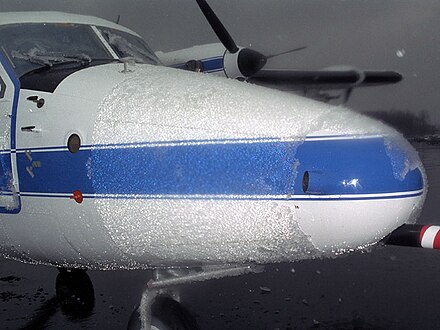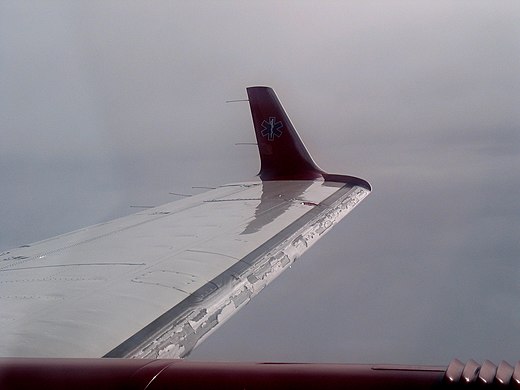Understanding In-Flight Airframe Icing
What is Airframe Icing?
Airframe icing happens when supercooled water in the atmosphere freezes upon contact with an aircraft's external surface during flight. This can create dangerous conditions that affect the plane’s performance.
How Does Ice Form on an Aircraft?
Although water normally freezes at 0°C, in the atmosphere, it can sometimes remain liquid even at lower temperatures. This is known as "supercooled" water. When an aircraft flies through clouds or moist air where temperatures are below freezing, this supercooled water can freeze onto the aircraft's surface.
The amount of ice that forms depends on:
- The size of the water droplets in the air.
- The way air moves around the aircraft.
- How much time the water has to freeze after hitting the plane.
In general, as temperatures drop further, there is less supercooled water, and by around -40°C, nearly all moisture turns to ice. However, in large storm clouds (like Cumulonimbus clouds), supercooled water can still exist at even lower temperatures.
Effects of Airframe Icing on Aircraft
Ice on an aircraft can cause serious problems, such as reduced performance, loss of lift, difficulty in controlling the plane, and even a potential stall. Here are some of the key dangers:
1. Aerodynamic Problems
When ice builds up on important surfaces like the wings, propellers, or tail, it can:
- Change the way air flows over the aircraft, reducing lift and increasing drag.
- Make the aircraft harder to control by affecting stability and trim.
- Cause uncommanded movements in control surfaces like ailerons and elevators, making it difficult or even impossible for the pilot to correct.
2. Blocked Pitot Tubes and Static Vents
Pitot tubes and static vents help measure altitude, airspeed, and vertical speed. If ice blocks these sensors, incorrect readings can mislead pilots. Most aircraft have built-in heating to prevent this, but if the heating system fails or isn't turned on, serious problems can arise. Ice crystal icing at high altitudes has also been known to cause temporary malfunctions in pitot tube heating.
3. Communication Issues
In the past, ice forming on unheated radio antennas sometimes caused communication problems. However, modern aircraft use improved radio systems that are less affected by icing.
4. Ice Falling from the Aircraft
When aircraft use de-icing systems in flight, ice that is removed is usually small and melts before reaching the ground. However, there have been cases where ice has fallen from waste drain masts on aircraft (such as those from galleys or toilets), causing minor property damage. If these masts are not heated properly, ice can form and later break off as "blue ice" when the aircraft descends into warmer air.
When an aircraft flies through cold, moist air, ice can form on its surface. This process, known as airframe ice accretion, can affect the aircraft's performance and safety. There are three main types of ice that can form: Rime Ice, Clear (or Glaze) Ice, and Mixed Ice (a combination of the two).
Types of Ice Formation
1. Rime Ice
Rime ice forms when small, supercooled water droplets freeze quickly upon hitting a cold aircraft surface. Because the transition to ice happens almost instantly, tiny air bubbles get trapped inside, creating a rough, brittle, and opaque (white) layer of ice.
🔹 Characteristics of Rime Ice:
- Rough and uneven surface.
- Brittle and can break easily.
- Forms on the leading edges of wings, stabilizers, and engine air inlets.
- Can disrupt airflow, reducing lift and increasing drag.
If rime ice continues to build up, it may form irregular shapes that stick out into the airstream, but there are natural limits to how large these ice formations can get.
2. Clear (Glaze) Ice
Clear ice forms when larger supercooled water droplets hit an aircraft surface but do not freeze immediately. Instead, the water spreads out before slowly freezing, creating a smooth, solid layer of ice.
🔹 Characteristics of Clear Ice:
- Transparent or slightly cloudy in appearance.
- Harder and more difficult to see compared to rime ice.
- Forms when freezing happens slowly, allowing water to spread.
- Can create large, smooth ice deposits that are harder to remove.
In some cases, clear ice can form unusual shapes, such as double ram’s horns, where ice builds up on both the top and bottom edges of the aircraft’s leading surfaces. Because clear ice is stronger than rime ice, these formations can grow quite large and significantly affect aircraft performance.
3. Mixed Ice
Mixed ice, also called cloudy ice, is a combination of rime and clear ice. It forms when supercooled water droplets of different sizes freeze at different rates, creating ice with both rough and smooth textures.
🔹 Characteristics of Mixed Ice:
- Most commonly encountered type of in-flight ice.
- Has both rough and smooth areas.
- Forms under a wide range of atmospheric conditions.
Other Important Ice-Related Terms
Supercooled Large Droplets (SLD)

Supercooled Large Droplets (SLD) are water droplets larger than 50 microns in diameter that remain liquid at temperatures below freezing. These droplets are often found in freezing rain or freezing drizzle and can pose a major icing risk.
Why are SLDs dangerous?
- Their large size makes them harder to deflect with airflow, meaning they can hit parts of the aircraft that are not protected by de-icing systems.
- When they freeze, they form clear ice, which is harder to detect and remove.
- SLD conditions are often associated with severe weather, including updrafts and wind shear.
Runback Ice
Runback ice forms when supercooled water lands on an aircraft surface, flows backward (aft), and then freezes further along the wing or tailplane.
Why is runback ice a problem?
- It often forms beyond the areas protected by de-icing systems.
- It can quickly build up, affecting the aircraft’s ability to generate lift.
- It is usually associated with large SLD droplets or ineffective thermal anti-icing systems.
Intercycle Ice
Intercycle ice forms in the short period between activations of a de-icing system. Most mechanical and thermal de-icing systems work in cycles, meaning ice can accumulate between cycles before being removed.
Key points about intercycle ice:
- It is a normal part of de-icing system operation.
- The time between de-icing cycles can often be adjusted by the pilot.
- Any ice that remains after a de-icing system has turned off is called residual ice.
How Ice Affects Aircraft Performance
When ice builds up on an aircraft, it can have serious effects on its ability to fly safely. Even a small amount of ice can change the way air flows over the wings and control surfaces, leading to problems with lift, drag, and stability.
How Ice Changes Aerodynamics
Aircraft are designed to fly with smooth, clean surfaces. When ice accumulates:
- The rough surface disrupts airflow, reducing lift and increasing drag.
- The aircraft may become harder to control as the balance and center of gravity shift.
- Ice adds extra weight, which can make the aircraft perform differently than expected.
One of the biggest dangers is that pilots may not get any warning before the aircraft’s performance changes. Stall warning systems are designed for an ice-free aircraft, so they may not activate in icing conditions. This means a stall or loss of control could happen suddenly, without warning.
Where and When Ice Forms
1. Icing in Clouds
Not all clouds cause ice formation, but if a cloud contains liquid water and the temperature is at or below 0°C, icing can happen.
- Cumulus clouds have larger water droplets, leading to rapid ice build-up.
- Stratus clouds have smaller droplets, but since they can stretch for long distances, flying through them for even a short time can cause a significant amount of ice to form.
- The worst icing conditions usually occur just below 0°C, often near the tops of stratiform clouds.
For turboprop aircraft, it may be dangerous to stay at these altitudes for too long.
2. Icing in Rain and Drizzle
Flying through freezing rain or drizzle is one of the most dangerous icing conditions.
- Even if visibility seems good, ice can build up very quickly on the aircraft.
- Pilots should exit these conditions as soon as possible by changing altitude or direction.
3. Icing and Snow
Snow by itself does not usually cause ice to form on an aircraft, because it is already frozen. However, there are some situations where snow can contribute to icing:
- If snow is mixed with liquid water in a cloud, it can help ice form.
- In Cumulonimbus anvil clouds, ice crystals can mix with Supercooled Large Droplets (SLD), leading to significant icing.
Why is Understanding Ice Accretion Important?
Understanding how different types of ice form and their effects on aircraft is essential for pilots and aviation professionals. Ice build-up can reduce lift, increase drag, and make an aircraft harder to control. By using anti-icing and de-icing systems properly and being aware of icing conditions, pilots can ensure safer flights.
Key Takeaways
- Even a small amount of ice can disrupt airflow and affect aircraft control.
- Ice can form quickly in clouds, freezing rain, or drizzle, especially near 0°C.
- Snow alone is not a major icing threat, but it can mix with water and contribute to ice formation.
- Pilots should avoid icing conditions by adjusting altitude or changing course when necessary.
Learn More - the Basic Aeronautical Knowledge Certificate Programme, is an effective way to demonstrate your knowledge and passion for aviation.
#aviationenglishasia #aviationenglish #BAK #basicaeronauticalknowledge #aviationtheory #flighttraining #pilottraining #hkaviation #vhhh #aviation #icaoenglish #pilot #atco #flying #piloting #studentpilot #Pilot #見習機師 #CadetPilot #機師英語要求 #ICAO英語 #ICAOtest #cadetpilotprogramme #icaoenglishtest #studentpilot #futurepilots #generalaviation




.jpg)